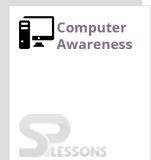 Introduction
Introduction
What is Computer Aptitude?
Computer Aptitude Test is a scientifically validated test designed to measure the aptitude for working with computers. Basically, it measures the ability to solve problems quickly that is essential to truly succeed in every field using computers.
Computers are an integral part of everyday life. Computer aptitude is an important section in many competitive exams primarily related to recruitment. Candidates preparing for banking exams like IBPS PO, SBI PO, and the RBI, must be prepared with Computer Aptitude syllabus.
"A Computer is a device that can be instructed to carry out sequences of arithmetic or logical operations automatically via computer programming". Computers follow a generalized set of operations termed as programs. The programs enable computers to perform an extremely wide range of tasks. Computers are now ubiquitous and are being used in every field of work. Thus, basic knowledge of computers and the ability to operate a computer is now crucial for all job aspirants.
Computer Awareness, also known as Computer Aptitude is one of the prominent sections in various recruitment related competitive exams in India. IBPS RRB Computer Awareness Quiz Day 5 lists some of the important questions for the preparation of Computer Awareness module. The most significant topics to be learnt for Computer Awareness module are as follows:
- History of Computers
- Computer Fundamentals
- Parts of a Computer System
- Data Processing Cycle of a Computer
- Computer Languages
- Input Devices & Output Devices
- Operating Systems
- Database Management Systems
- Microsoft Office
- Keyboard Shortcuts
- File Extensions
- Networking and Internet
- Computer Viruses
- Important Abbreviations
 Quiz
Quiz
1. Programs tend to make memory accesses that are in proximity of previous access this is called
- A. spatial locality
B. temporal locality
C. reference locality
D. access locality
- A. Link Address
B. Logical address
C. layer address
D. Port Address
- A. Image source format
B. bitmap image format
C. Cursor image file.
D. Both B and C
- A. Public Key of user A
B. Public Key of user B
C. Private Key of user A
D. Private Key of user B
- A. 1111110000
B. 1111111010
C. 111111000
D. 111111
1. Which of these is the band specification for Bluetooth-2.4-GHz band divided into
- A. 77 channels of 1 MHz each
B. 78 channels of 1 MHz each
C. 79 channels of 1 MHz each
D. 80 channels of 1 MHz each
- A. Wavelength hopping Spread Spectrum (WHSS)
B. Time hopping Spread Spectrum (THSS)
C. Frequency hopping Spread Spectrum (FHSS)
D. All of these
- A. 802.11
B. 802.11a
C. 802.11b
D. 802.11c
- A. Interpacket Space
B. Interframe Space
C. Intermessage space
D. transmission delay
- A. frame transmission
B. Addition of persistence process
C. Jamming signal
D. All of the above
1. What is maximum throughput for slotted ALOHA ?
- A. 0.184 when G = 1
B. 1.84 when G = [latex]\frac{1}{2}[/latex]
C. 0.184 when G = [latex]\frac{1}{2}[/latex]
D. 1.84 when G=1
- A. t+1
B. 2t+1
C. 2t
D. T
- A. s+1
B. 2s+1
C. 3s+1
D. s
- A. size of sender and receiver window must be less than 2m
B. size of sender and receiver window must be greater than 2m
C. size of sender and receiver window must be at most one half of 2m
D. size of sender and receiver window must be at least one half of 2m
- A. One
B. Two
C. Three
D. One or more
Other Articles
 Study Guide
Study Guide
| Competitive Exams - Study Guide | ||
|---|---|---|
| Category | ||
| Quantitative Aptitude | Reasoning Ability | General Awareness |
| Computer Awareness | English Knowledge | Banking Awareness |
| General Science | World of Words | Descriptive Test |
 Exams
Exams
| Competitive Exams - College Entrance Exams | |||
|---|---|---|---|
| Category | Notification | ||
| PG | GATE 2020 | ATMA 2019 | |
| Click Here For – All India Entrance Exam Notifications | |||
 Daily CA
Daily CA
 Job-Alerts
Job-Alerts
 SP Quiz
SP Quiz
| Competitive Exams - Practice Sets | |
|---|---|
| Category | Quiz |
| Quant Aptitude | Seating Arrangement |
| Profit and Loss | |
| Reasoning Ability | Puzzles |
| Insurance Awareness | Insurance Awareness |
 GK
GK
| General Knowledge for Competitive Examinations | |
|---|---|
| Topic | Name of the Article |
| GK - World | Multinational Companies Headquarters |
| Grammy Awards 2019 | |
| GK - India | Niti Aayog Objectives for India 2022- 2023 |
| NITI Aayog | |
| GK - Abbreviations | Insurance Domain Abbreviations |
| GK - Banking & Insurance | African Countries Capitals Currencies |
| Asian Countries Capitals Currencies | |
| GK - Science & Technology | Indian Research Institutes |
| Ama Ghare LED Scheme | |



